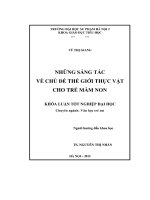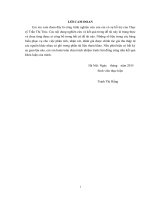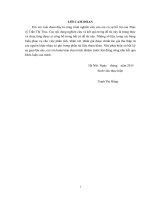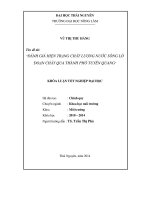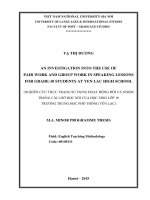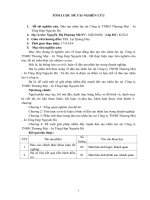Khóa luận tốt nghiệp a survey of learners attitudes when the teacher uses storytelling in speaking lessons for primary school students at blooming kids english center
Bạn đang xem bản rút gọn của tài liệu. Xem và tải ngay bản đầy đủ của tài liệu tại đây (1.23 MB, 80 trang )
VIET NAM NATIONAL UNIVERSITY OF AGRICULTURE
FACULTY OF EDUCATION AND FOREIGN LANGUAGES
BA THESIS
A SURVEY OF LEARNERS’ ATTITUDES WHEN THE
TEACHER USES STORYTELLING IN SPEAKING
LESSONS FOR PRIMARY SCHOOL STUDENTS AT
BLOOMING KIDS ENGLISH CENTER
KHẢO SÁT THÁI ĐỘ CỦA NGƯỜI HỌC KHI
GIÁO VIÊN SỬ DỤNG HOẠT ĐỘNG KỂ CHUYỆN
TRONG CÁC BUỔI HỌC NÓI CHO HỌC SINH
TIỂU HỌC TẠI TRUNG TÂM ANH NGỮ
BLOOMING KIDS
Student
: DANG THI MAI UYEN
Student code
: 621202
Major
: ENGLISH LINGUISTIC
Supervisor
: TRAN THU TRANG, M.A
HANOI – 2021
VIET NAM NATIONAL UNIVERSITY OF AGRICULTURE
FACULTY OF EDUCATION AND FOREIGN LANGUAGES
BA THESIS
A SURVEY OF LEARNERS’ ATTITUDES WHEN THE
TEACHER USES STORYTELLING IN SPEAKING
LESSONS FOR PRIMARY SCHOOL STUDENTS AT
BLOOMING KIDS ENGLISH CENTER
KHẢO SÁT THÁI ĐỘ CỦA NGƯỜI HỌC KHI
GIÁO VIÊN SỬ DỤNG HOẠT ĐỘNG KỂ CHUYỆN
TRONG CÁC BUỔI HỌC NÓI CHO HỌC SINH
TIỂU HỌC TẠI TRUNG TÂM ANH NGỮ
BLOOMING KIDS
Student
: DANG THI MAI UYEN
Student code
: 621202
Major
: ENGLISH LINGUISTICS
Supervisor
: TRAN THU TRANG, M.A
HANOI – 2021
ACKNOWLEDGEMENT
In order to complete the graduation thesis with the topic of “A survey of
learners’ attitudes when the teacher uses storytelling in speaking lessons for
primary school students at Blooming Kids English Center”, besides my own
constant efforts, I have received a lot of attention and support from teachers,
family and friends.
I would like to express my sincerest thanks to the teachers in the Faculty
of Education and Foreign Languages, Vietnam National University of
Agriculture. In particular, I would like to express my sincerest and deepest
thanks to M.A. Tran Thu Trang for her enthusiastic guidance and support during
the process of completing my graduation thesis.
Next, I would like to thank the director and management team at
Blooming Kids English Center and the students there for creating the best
conditions for me to learn and understand the issues related to the process. do a
thesis at the center.
Finally, I would like to thank my family and friends who always
encouraged and helped me when I faced some difficulties.
During the process of doing my graduation thesis, I feel that I have
learned and experienced many useful things. From there, let me learn and draw
experience for my future working process.
My thesis will not be able to avoid limitations and shortcomings. I look
forward to receiving comments and suggestions from teachers and classmates to
help improve the thesis.
Ha Noi, 24th May 2021
The writer
Dang Thi Mai Uyen
i
CERTIFICATE OF ORIGINALITY
I, the undersigned, hereby certify my authority of the study project report
entitled “A SURVEY OF LEARNERS’ ATTITUDES WHEN THE TEACHER
USES STORYTELLING IN SPEAKING LESSONS FOR PRIMARY
SCHOOL STUDENTS AT BLOOMING KIDS ENGLISH CENTER”
submitted in partial fulfillment of the requirements for the degree of Bachelor in
English Language. Except where the reference is indicated, no other person’s
work has been used without due acknowledgement in the text of the thesis.
Hanoi, 2021
Approved by
SUPERVISOR
(Signature and full name)
Date:……………………
ii
TABLE OF CONTENTS
ACKNOWLEDGEMENT ..................................................................................... i
CERTIFICATE OF ORIGINALITY .................................................................... ii
TABLE OF CONTENTS ..................................................................................... iii
ABSTRACT ......................................................................................................... vi
LIST OF TABLES AND FIGURES ................................................................... vii
PART 1: INTRODUCTION ................................................................................ 1
1.1 RATIONALE FOR THE STUDY .................................................................. 1
1.2 AIMS AND OBJECTIVES OF THE STUDY ............................................... 2
1.2.1 Aims of the study ......................................................................................... 2
1.2.2 Objectives of the study ................................................................................. 2
1.3 RESEARCH QUESTION ............................................................................... 2
1.4 SCOPE OF THE STUDY ............................................................................... 2
1.5 SIGNIFICANCE OF THE STUDY ................................................................ 3
1.6 DESIGN OF THE STUDY ............................................................................. 4
PART 2: DEVELOPMENT .................................................................................. 5
CHAPTER 1: LITERATURE REVIEW .............................................................. 5
1.1 REVIEW OF THE PREVIOUS STUDIES .................................................... 5
1.2 REVIEW OF THEORETICAL BACKGROUND ......................................... 9
1.2.1 Speaking skills.............................................................................................. 9
1.2.2 Storytelling ................................................................................................. 11
1.2.3 Attitude ....................................................................................................... 14
iii
1.3 SUMMARY .................................................................................................. 16
CHAPTER 2: METHODOLOGY ...................................................................... 18
2.1 RESEARCH GOVERNING ORIENTATION ............................................. 18
2.2 RESEARCH METHODOLOGY .................................................................. 18
2.2.1 Definitions of action research (AR) ........................................................... 18
2.2.2 Rationale for choosing action research ...................................................... 19
2.2.3 The procedures of action research.............................................................. 21
2.2.4 Classroom procedures ................................................................................ 26
2.2.5 Data collection instruments ........................................................................ 27
2.3 SUMMARY .................................................................................................. 29
Chapter 3: FINDINGS AND DISCUSSIONS .................................................... 30
3.1 RESULTS OF THE QUESTIONNAIRES ................................................... 30
3.1.1 The affective aspect of attitude towards learning speaking ....................... 30
3.1.2 The behavioral aspect of attitude towards learning speaking .................... 32
3.1.3 The cognitive aspect of attitude towards learning speaking ...................... 34
3.1.4 Students’ positive evaluation on the effects of storytelling ....................... 37
3.1.5 Students’ negative evaluation on the effects of storytelling ...................... 39
3.2 RESULTS OF PERSONAL INTERVIEWS ................................................ 40
3.2.1 Analyzing the students’ answers for interviews ........................................ 40
PART 3: CONCLUSION .................................................................................... 46
3.1 RECAPITULATION .................................................................................... 46
3.2 CONCLUDING REMARKS ........................................................................ 46
3.3 LIMITATION OF THE STUDY .................................................................. 47
iv
3.4. RECOMMENDATIONS/SUGGESTIONS FOR FURTHER STUDY ...... 47
3.4.1 For teachers ................................................................................................ 48
3.4.2 For other researchers .................................................................................. 48
3.5 SUMMARY .................................................................................................. 48
REFERENCES .................................................................................................... 49
APPENDIX ......................................................................................................... 52
APPENDIX 1: PRE-QUESTIONNAIRES ......................................................... 52
APPENDIX 2: POST-QUESTIONNAIRE ........................................................ 54
APPENDIX 3: INTERVIEW QUESTIONS ...................................................... 57
APPENDIX 4: RESULTS OF THE QUESTIONNAIRES ................................ 58
APPENDIX 5: TRANSCRIBE STUDENTS’ INTERVIEW DATA................. 61
APPENDIX 6A: A SAMPLE LESSON PLAN .................................................. 68
APPENDIX 6B: UNIT 6: THE BEST BED!...................................................... 71
v
ABSTRACT
The aim of this thesis is to find out the influence of storytelling activities
on students' attitudes towards their learning to speak. An action research project
was conducted in 4 classrooms at Blooming Kids English Center. Storytelling
was conducted over the 12 weeks of term 2. Participants (60 primary school
students) answered two questionnaires at the beginning and end of the semester.
In addition, the students were interviewed at the end of the semester.
Questionnaires and interviews were used to collect data on students' attitudes
towards learning speaking when teachers used storytelling in English speaking
lessons. The data collected before the intervention showed that the students were
reluctant and afraid to speak English. However, after the 12-week action
research project, the students showed positive attitudes towards the speaking
lessons. It was concluded that storytelling could have beneficial effects on
learners' attitudes towards learning speaking skills.
Key word: attitudes, storytelling, speaking lessons
vi
LIST OF TABLES AND FIGURES
Figure 2.1 : Cyclical AR model based on Kemmis and McTaggart (1988)……21
Figure 3.1: The affective aspect of attitude before and after intervention..……30
Figure 3.2: The behavioral aspect of attitude before and after intervention…...32
Figure 3.3: The cognitive aspect of attitude before and after intervention….....34
Figure 3.4: Students’ positive evaluation on the effects of storytelling…….….37
Figure 3.5: Students’ negative evaluation on the effects of storytelling…….…39
vii
PART 1: INTRODUCTION
1.1 RATIONALE FOR THE STUDY
Education is one of the particularly important fields, of interest to the Party,
the State and the whole society, investing in all educational levels; especially
primary level - the initial stage to get used to learning activities in general and
English language in particular. In addition to the remarkable achievements in
improving the quality of English teaching and learning in primary schools, there
are still many limitations that need to be overcome, especially the speaking
skills of children.
Currently, there is a large part of children who are learning English the
wrong way, with a reversed sequence: Writing – Reading – Listening Speaking. Children learn English in a passive and extremely boring way, the two
skills of Listening and Speaking are not focused properly but only interested in
grammar. The wrong teaching method both limits the child's English
communication skills while forming a habit of being afraid to communicate,
making wrong pronunciation, and the more they grow up, the more difficult they
will be to correct.
Obviously, to communicate in any language, but specifically English,
speaking skill is the golden key to learning English better, helping students
improve their proficiency and confidence to communicate. Realizing the
limitations of traditional teaching, recognizing the importance of speaking skills,
as an English teacher, I have been constantly searching for different methods to
improve learning to speak as well as creating excitement for learners. There are
many ways to improve students' English speaking: using English songs;
watching short English cartoons, … Among the above methods, I have found
that: the method of using storytelling activities is very suitable for students.
Because the storytelling method is suitable for the psychology of elementary
school age, not only brings a lot of fun and excitement for children in the
1
learning process, it also helps stimulate the creative movement of their
intelligence because students will actively use English in a flexible way.
In short, for the purpose of helping students learn English effectively,
teachers need to have good teaching methods, not simply imparting knowledge
but also inspiring and motivating learners. In order to objectively evaluate the
impact of teaching methods by storytelling activities during speaking lessons for
primary school students, specifically for 10-year-olds, I have conducted this
study to assess the attitudes of learners. and the effectiveness of the above
method.
All of the above–mentioned arguments present a need to carry out “A
survey of learners’ attitudes when the teacher uses storytelling in speaking
lessons for primary school students at Blooming Kids English Center”.
1.2 AIMS AND OBJECTIVES OF THE STUDY
1.2.1 Aims of the study
The main aim of the study is to investigate the attitudes of learners when
using storytelling as a classroom activity in teaching speaking skills.
1.2.2 Objectives of the study
The objective of this study is to reveal the students’ emotional reaction
through 3 components of attitude: affective component, behavioral component
and cognitive component.
1.3 RESEARCH QUESTION
To achieve the aims, the following research question will be solved:
What are the students’ attitudes towards learning speaking when the
teacher uses storytelling technique in speaking lessons?
1.4 SCOPE OF THE STUDY
The study focuses on using storytelling technique in speaking lessons to
investigate attitudes of 60 students at 5th grade of Blooming Kids English
2
Center. I teach here for 4 months in the second semester, 8 periods a week,
applied to the textbook Family and Friends 4.
1.5 SIGNIFICANCE OF THE STUDY
In today's integration trend, the importance of English cannot be denied and
ignored, because it is widely used all over the world. Recognizing such
importance, most of the countries where English is not the main language are
trying to develop more languages. And Vietnam is no exception, here English
has become one of the main subjects in the student's curriculum. The Ministry of
Education and Training in Vietnam is always interested and constantly improves
and innovates the curriculum to be more suitable for students. Instead of only
focusing much on grammar before, nowadays it focuses more on developing
four skills, especially speaking skills. According to Nunan (1991, p.39), “For
most learners, mastery of speaking is the most important element of learning a
foreign language and success in speaking is assessed by ability to develop a
conversation in that language”. Thereby, we see that speaking skills are one of
the very important keys to the success in developing a language and moreover,
teachers' teaching methods also affect learners.
During class time, the teacher is the communicator, the student's child is
the receiver. The success of a verifiable lesson is determined by the teacher's
teaching method. Good and creative teaching methods, students will be
interested in learning which also means that their ability to absorb will be higher
and vice versa. Therefore, the teacher's teaching methods have a significant
impact on the students' ability to receive. Seeing the importance of teaching
methods, I have been constantly thinking and searching for good teaching
methods to apply in lessons, especially teaching methods for English speaking
lessons. During my research time, I found that the method of using storytelling
activities for English speaking lessons was very effective. So, I decided to do the
topic “A survey of learners’ attitudes when the teacher uses storytelling in
3
speaking lessons for primary school students at Blooming Kids English center”
to see the attitude of students as well as recommend this method, for teachers to
make speaking lessons more effective and enjoyable.
1.6 DESIGN OF THE STUDY
The thesis is organized into 3 main parts: Introduction, development, and
conclusion.
Part 1: Introduction, presents the rationale why the researcher chose the
topic, states the aim, the research significance, the scope and outlines the
organization of the thesis.
Part 2: Development, includes 3 chapters. Chapter 1 covers theoretical
background related to the issues such as teaching speaking and storytelling
techniques. It also includes some previous studies related to using storytelling in
language speaking classes. Next chapter 2 describes the research method –
action research, the data collection instruments and information of participants
in the study and the steps to conduct the study. And chapter 3 Findings and
discussion, analyzing the collected results of questionnaires and personal
interviews
Part 3: Conclusion, presents the recapitulation, concluding remarks,
limitation of the study and recommendations/suggestions for further study.
4
PART 2: DEVELOPMENT
CHAPTER 1: LITERATURE REVIEW
1.1 REVIEW OF THE PREVIOUS STUDIES
In the past, a number of studies have been done on the use of storytelling
in teaching English.
According to Mukminatus Zuhriyah (2017), in the study titled
“Storytelling to improve student's speaking skill”, research has shown that:
Storytelling can improve N students' speaking skills in the second semester of
Hasyim Asy'ari University (UNHASY) Tebuireng Jombang in 2016 -2017. This
research was a collaborative action research and consists of 4 steps: planning,
implementing, observing, and reflecting. The researcher was the lecturer of an
intensive English program in class N. Meanwhile, the collaborator was another
lecturer of an intensive English program from another class. The collaborator
was given a lesson plan of speaking class by using storytelling method for class
N. The collaborator was also given observation sheets in the form of the field
notes to report the lecturer’s activities, and student’s activities, and student’s
responses during the lecturer taught speaking using storytelling method in class
N. Based on observation and speaking test, it can be seen that the percentages of
students passing the passing grade of each speaking aspect in post-test I was less
than 75%. So that it could be said that cycle one was unsuccessful. Meanwhile,
the percentages of students passing the passing grade of each speaking aspect in
post-test II could reach 75 %. It means that cycle two was considered successful.
The student’s speaking skill improved in all aspects of speaking, such as
comprehension, fluency, vocabulary, grammar, and pronunciation. Thereby we
see the effectiveness of using storytelling activities in teaching speaking, but that
research only applies to university students of Hasyim Asy’ari and not yet
research for other subjects.
5
A conducted a study “Using storytelling to improve literacy learning”
(2017) by Rezeki Ikrammuddin, the author states that storytelling can improve
student speaking skills with monitoring for improvement. Based on the data
analysis, the researcher found that storytelling technique can improve students’
skill in speaking. As the result from the pre-test and post-test mean scores which
were given. The improvement of the mean score was 72.6 to 84. Then, it is also
proved by examining the hypothesis that to is higher than table (4,88 > 1,677). It
means that there is a significant difference of achievement between the students
who were taught by using storytelling technique and the students who were
taught without storytelling technique. Thus, it can be concluded that using
storytelling technique to the students at Insan Qur’ani Boarding School can
improve their skill in speaking. Moreover, the students were also given the
questionnaire to know their responses toward storytelling technique. The data
also showed that students felt that storytelling technique could help them in
speaking. Most of them also responded that they attempt to use storytelling
technique in their daily speaking
Besides, the author Tri Jampi Setiyorini with the research paper “The
effect of using digital storytelling on student's intrinsic movation for learning”
(2020) has shown that: before, teachers would explain each vocabulary, students
would feel It is easy to get bored, but after using storytelling, students feel more
excited. Using a data collection tool using questionnaires and interviews, the
author found that 'digital storytelling' helps students motivate students to learn
vocabulary and furthermore, students know more vocabulary and more. grasp
better vocabulary. In this research paper, the author not only used storytelling
activities but also used other media such as: sound; image and sound.
In addition, according to the study “Teaching vocabulary using
storytelling” by Linda Ismawati. This research intends to find out whether
storytelling could improve students’ vocabulary achievement. In this research,
6
the quantitative research was applied using One-group pretest posttest design
since there would be one experimental class which received treatments and also
got pre-test and post-test. The subjects in this research were 31 students of VIII
A of SMPN 3 Bunga Mayang. The instruments used in this research are
vocabulary test and oral test. There is a significant difference in the students’
vocabulary achievement which is taught by using Storytelling Technique. The
result shows that the mean score of the post-test is significantly higher than in
the pre-test. The students’ mean score increased from 47.13 up to 73.90 which
the gain is 26.77 specifically. Storytelling is able to make students understand
the meaning of the word and remember it in longer. The data show that meaning
has the highest increase in vocabulary. The increase of meaning is 45.8 up to
77.8 and the gain is 32. It is because the teacher presents target words by
showing its picture so that the meaning is perfectly clear and unambiguous.
Then, the students can guess the meaning from the clue while listening to the
story and the words remain longer in their mind.
In another study by Munawaroh (2012), with the topic “Using Storytelling
to improve speaking skills of the student of MTs AL-Ghozali Panjer” showed the
effectiveness of applying storytelling method in learning. to speak. This research
paper has solved the question: Can the speaking skills of the second year
students of MTs Al-Ghozali Panjer in the academic year 2011/2012 be improved
through storytelling technique? The researcher used two tests to evaluate the
results: before study and after study. The results are: The first test has an
average score of 31.03%, and the second test has an average score of 86.21%. A
clear improvement can be seen in these two tests. In addition, Munawaroh also
used questionnaires, which showed that most students enjoy and absorb best
when learning this method. Thereby, we can see that this method really has a
positive effect on the speaking ability of middle school students of high school
at Insan Qur'ani Boarding School.
7
Moreover, according to the study “A study on using storytelling to improve
english speaking for students at a primary school in hanoi” by Pham Thi Han
(2020). The author says: "Storytelling brings great effective in developing
speaking". This study was an investigation into the effectiveness of teaching
young learners to speak through storytelling. The main aim of the study was to
determine whether storytelling had an extended impact on the speaking ability
of young learners. The author conducted research to examine the effectiveness
of using storytelling in developing students' speaking skills and attitudes through
this strategy. Fourteen students from grade 3 were selected as study participants.
They all took an eight-week speaking course designed by the researcher. All
participants were required to take a pre-test so that the researcher could test the
students' speaking ability before treatment. After that, the classes applied the
speaking lessons with 2 stories. After these lessons, these students were asked to
take a speaking test similar to the previous test (post test) to test the student's
improvement in speaking skills after the treatment. The researcher also uses two
other data collection tools, questionnaires and observations, which are written by
the researcher after each lesson, to search for data. The data collected from the
tests, questionnaires and observations mentioned above were then analyzed
quantitatively. The data analysis helped the researchers achieve the goal of the
study. After analyzing 43 questionnaires and observations, the researcher found
that most students prefer to learn to speak by telling stories. In addition, students
have a positive attitude towards storytelling because it helps students become
more confident, active, creative and eager to learn.
Thus, the above studies have shown that the use of storytelling has
benefits in many ways such as increasing vocabulary; improving English
speaking ability for students ... However, the target is primary school students
not mentioned. So, this is an opportunity for me to expand and develop more
8
methods of using storytelling in speaking classes for elementary school
students.1
1.2 REVIEW OF THEORETICAL BACKGROUND
1.2.1 Speaking skills
1.2.1.1 The concept of speaking skills
Speaking is the first way to interact with others in the social community.
Speaking is the delivery of language through the mouth. To speak, we create
sounds using many parts of our body, including the lungs, vocal tract, vocal
choreds, tongue, teeth and lips2
According to the Oxford dictionary, Speaking is an action used to tell
someone about something or communicate with others.3 Additionally, Gert and
Hans said that (as cited in Efrizal, 2012, p.127), “speaking is speech or
utterances to have the intention to recognize their intentions” Therefore, students
should have good english speaking ability to communicate easily and effectively
with other people. Besides, Underwood (1997: 11) once claimed: speaking is the
creative process; Positive interaction between speaker and listener involves
thoughts and feelings, speaking has three areas of knowledge: pronunciation,
grammar, and vocabulary.
For every foreign language learner, speaking skill is extremely important,
to master this skill requires a good study method. One of them is the storytelling
method, which helps each person to have the ability to present their story, give
their ideas, and use language flexibly. In this study, I will go into depth analysis
of the effectiveness of the storytelling method when applied to a specific
audience.
1
Linda Ismawati, Cucu Sutarsyah, Ari Nurweni, “Teaching vocabulary using storytelling” University of
Lampung.
2
“What is speaking?” />
3
/>
9
1.2.1.2 Teaching of speaking skills
According to Hornby (1995: 37) teaching means giving the instruction to
(a person): give a person (knowledge skill, etc). While speaking means to make
use of words in an ordinary voice. Therefore, teaching speaking is instructing a
person to communicate with others. Therefore, the goal of teaching speaking is
to help students improve communication skills, easily express ideas and use
language effectively. Teachers need to create a good learning atmosphere and
create conditions for students to develop pronunciation, fluency, intonation,
vocabulary, and grammar.
Nowadays, there are many procedures to teach speaking English. For
example, in the Book Teaching Speaking (Goh and Burns) recommended a
seven-stage cycle of activities in a speaking lesson:4
1. Focus learners’ attention on speaking: Students think about a speaking
activity, what it involves and what they can anticipate.
2. Provide input and/or guide planning: This may involve pre-teaching
vocabulary, expressions or discourse features and planning for an activity they
will carry out in class (e.g a presentation or a transaction).
3. Conduct speaking task: Students practice a communicative speaking
task with a focus on fluency.
4.
Focus
on
language/skills/strategies: Students
examine
their
performance or look at other performances of the task, as well as transcripts of
how the task can be carried out, and review different features of the task.
5. Repeat speaking task: The activity is performed a second time.
6. Direct learners’ reflection on learning: Students review and reflect on what
they have learned and difficulties they encountered.
Tourya Saada “What are the stages of a speaking lesson?” Date of access: 24/2/2021
4
10
7. Facilitate feedback on learning: Teacher provides feedback on their
performance.
In addition, there are other English teaching procedures that are also
commonly used such as: 5
1. Providing a model text: Comprehension and model analysis (e.g
studying the genre’s distinctive features)
2. Practice (Working on the language needed to perform the task)
3. Task setting (Understanding the topic/situation)
4. Planning (Structuring the output)
5. Production (Preparing for the spoken task; Going through the process of
drafting, revising, and editing)
6. Feedback (self or peer-regulated feedback using a checklist or teacherregulated.)
Thus, depending on the age and knowledge base, each teacher will have a
different teaching sequence to suit students and bring the best results.
1.2.2 Storytelling
1.2.2.1 What is storytelling?
Storytelling has been practised for thousands of years. Cave people
employed pigment to create stories and myths by painting on walls with their
hands. The ancient Greeks etched their language onto the walls of their cities to
show how history was progressing. The narrative voice in writing reveals a great
deal about each culture's daily existence.6
According to Wikipedia, Storytelling describes the social and cultural
activity of sharing stories, sometimes with improvisation, theatrics or
embellishment. Crucial elements of stories and storytelling include plot,
Mohammed Rhalmi “Teaching productive skills/ speaking and writing” date of access: 24/2/2021
/>6
“The History of storytelling” />t%20each%20of%20the%20culture%E2%80%99s%20everyday%20life.
5
11
characters and narrative point of view. In another word, storytelling is the use of
stories or narratives as a communication tool to value, share, and capitalize on
the knowledge of individuals. Storytelling is the vivid description of ideas,
beliefs, personal experiences, and life lessons through stories or narratives that
evoke powerful emotions and insights. Storytelling is one of the most powerful
means that people have to influence, teach, and inspire. Because it helps people
connect better.7 Interaction makes people get along and understand each other
better. Good stories do more than create a sense of connection.
Thus, over thousands of years of history, storytelling has been widely
applied in human daily activities, especially in the field of education. Using the
storytelling method in teaching speaking is increasingly used, the study of
storytelling for Vietnamese students is important and necessary.
1.2.2.2 How to use storytelling?
Storytelling helps people understand, make sense of the world around
them, and realize a deeper meaning in life. Since then, storytelling can be said to
be a part of life. There are many stories, but not everyone knows how to convey
them in a way that is attractive and unique. There are many ways to implement
storytelling technique in language classes. In my action research, I followed the
5 suggested activities which were stated by Jianing (2007). I chose Jianing's
activities because I think they will be suitable for my class size (15 students each
class), age-appropriate (10 years old) and moreover, these activities are very
interesting and useful.
Those activities are:
Activity 1:
Divide the students into groups and each group prepares a story. Each
member of the group tells two to three sentences and the next one continues
until the end of the story. The length of the story could gradually increase from
12
two or three minutes to four or five minutes. Before the lesson, the students
could divide their tasks in advance and practice their own parts. They could also
be given a few minutes to practice in class the whole story if necessary. The
teacher moves among the groups and chooses two or three groups to present
their stories before the class. Because the students have enough time to prepare
and they are working together, this helps them build confidence and create a
lively and brisk atmosphere.
Activity 2:
Ask each student to prepare a story (about two minutes long) in advance.
Divide the students into groups with four to five members in each group and ask
them to tell his/her story in the group. The best storytellers in each group win ten
points and compete for the best storyteller of the class. The winner wins another
ten points for each member of his/her group and the second best wins eight
points and so on. Since the performance of each representative is connected to
the score of everyone, the students will be greatly involved in the whole process
and listen to the stories attentively, which will in turn promote the performance
of the storytellers.
To avoid the few best storytellers dominating the activity, the best
storytellers will be arranged in the same group next time. They will have to
work harder in order to win again. This will make the winners stronger and at
the same time, increase the opportunities of others and promote the whole class
participation.
Activity 3:
Divide the students into four to five groups and each group is given an
opening of a story and asked to finish the story in about 20 minutes. Then select
one student from each group to tell their story in the class and the best one wins
10 points for their group.
13
To get everyone fully involved and avoid the liability that each group just
asks their best storyteller to do the job, the storytellers are selected by drawing
lots instead of being chosen by themselves. This also helps enliven the
atmosphere of the classroom. So, each group must work together to make the
story as interesting as they can. An alternative way is to ask each member of the
group to tell a part of the story and make a whole.
Activity 4:
Ask each group to hand in an incomplete story and redistribute them
among the groups. Give the students 20 minutes to read their stories and finish
them. After each group presents their story, compare it with the original one.
The most interesting one and the one closest to the original win.
Activity 5:
The teacher gives the first sentence to the class and then each student adds
one more sentence to make a whole story impromptu. Because there is no
preparation and nobody has any idea about what the next person will say and
where the story is going, there are often lots of fun and surprises in the game.
Through that, it can be seen that there are many ways to use storytelling in
speaking lessons. Teachers need to use flexibility to increase interest and
achieve efficiency.
1.2.3 Attitude
1.2.3.1 What is attitude?
There are many different views on the concept of attitude.
According to Hogg and Vaughan, Attitude is "a relatively enduring
organization of beliefs, emotions, and behavioral tendencies towards objects,
groups, events or symbols of social significance" (2015, p. .150) Or according to
Eagly and Chaiken, the attitude is "…a psychological tendency that is expressed
by evaluating a particular entity with some degree of favor or disfavor" (1993,
p.1).
14
In psychology, attitudes refer to a set of feelings, beliefs, and behaviors
toward a particular object, person, thing, or event. Attitudes are often the result
of experience or upbringing, and they can have a powerful influence on
behavior.
Psychologists define attitude as a learned disposition to judge things in a
certain way. This may include evaluations of people, problems, objects, or
events. Such reviews are usually positive or negative, but they can also be
uncertain at times.
Researchers have said that attitudes have three components known as the
ABC model: affective component, behavioral component and cognitive
component.
Altogether, attitude is an emotional state expressed into human behavior.
1.2.3.2 Components of attitude
The responses elicited by attitude objects have often been described by
psychologists as belonging to three classes: affective, behavioral and cognitive
(e.g., Breckler, 1984; D. Katz & Stotland, 1959; Rosenberg & Hovland, 1960).
The cognitive category contains thoughts, the affective category consists of
feelings or emotions, and the behavioral category encompasses actions and
intentions to act. These thoughts, feelings, and behaviors are all directed to the
entity that is the object of the attitude.
- The affective component: Attitudes also encompass affective reactions
that were elicited by the attitude object and therefore became associated with it.
The affective aspect of attitude structure consists of feelings, moods, emotions,
and sympathetic nervous system activity that people have experienced in
relation to an attitude object and subsequently associate with it. Like beliefs,
these effects might reflect particular experiences or become more generalized by
summarizing responses that occur on multiple occasions. Like cognitive
15
responses, these affective responses also ex- press positive or negative
evaluation of greater or lesser extremity.
- The behavioral component: The behavioral aspect of intra-attitudinal
structure refers to associations that encompass a person's overt actions toward
the attitude object as well as intentions to act, which are not necessarily
expressed in overt behavior. Although representations of particular behaviors
become associated with attitude objects, behavioral representations may, like
cognitions and affects, become generalized on the basis of repeated responding.
Like cognitive and affective responses, behavioral responses also express
positive or negative evaluation of greater or lesser extremity.
- The cognitive component: The cognitions or thoughts that are associated
with attitudes are typically termed beliefs by attitude theorists. Beliefs are
understood to be associations or linkages that people establish between the
attitude object and various attributes that they ascribe to them (Fishbein &
Ajzen, 1974). Beliefs express positive or negative evaluation of greater or lesser
extremity and occasionally are exactly neutral in their evaluative content. Many
beliefs are concrete, in the sense that they reflect specific images. Often beliefs
are more abstract, sometimes because they summarize many observations of
similarity.
1.3 SUMMARY
In this chapter I mentioned two main issues: Review of previous studies,
Review of theoretical background.
Regarding the Review of previous studies, I have researched and studied
many other research papers such as: “Storytelling to improve student's speaking
skill”of Mukminatus Zuhriyah (2017); “Using storytelling to improve literacy
learning” (2017) by Rezeki Ikrammuddin; “The effect of using digital
storytelling on student's intrinsic movation for learning” by Tri Jampi Setiyorini
(2020); “Teaching vocabulary using storytelling” by Linda Ismawati and “Using
16
